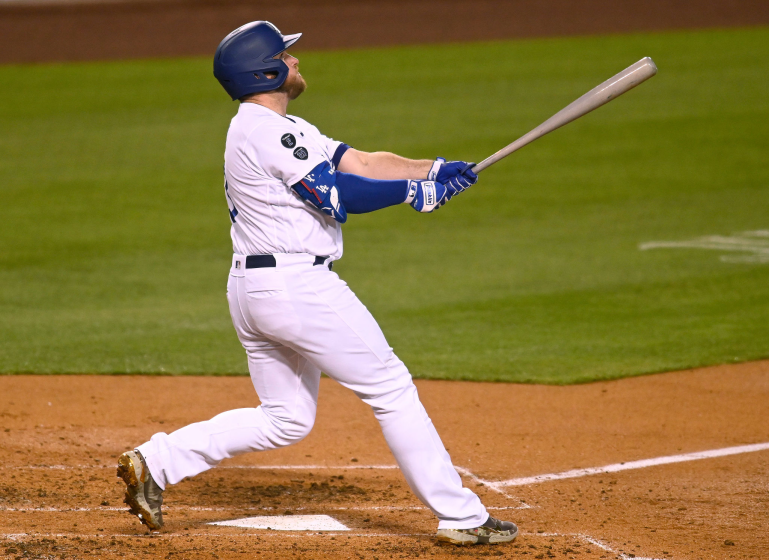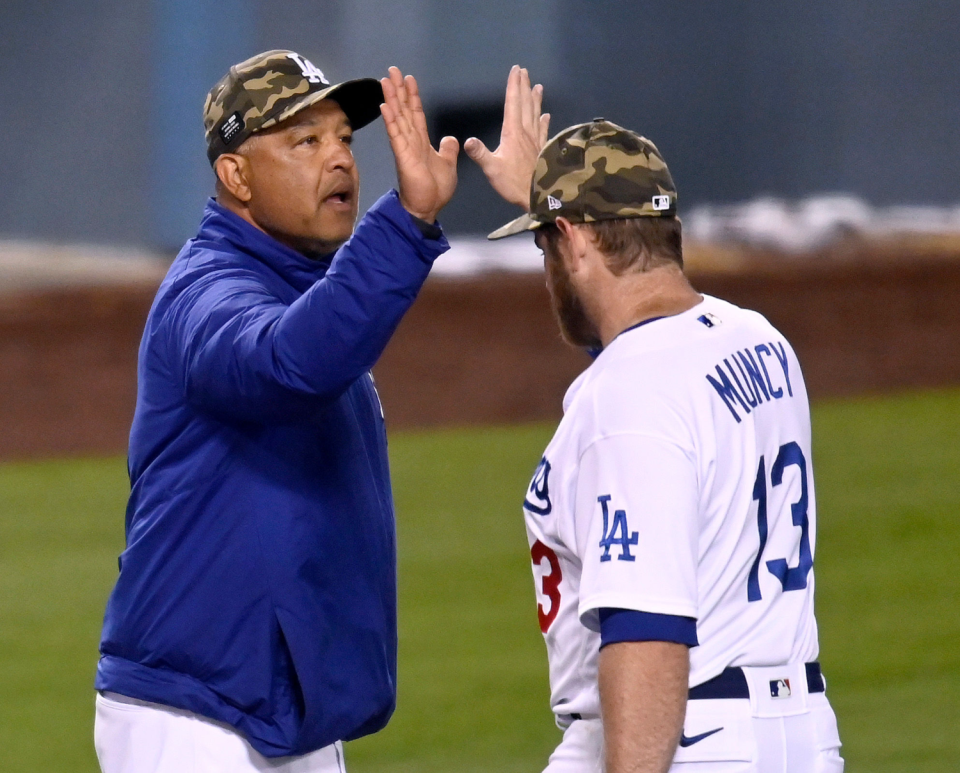Max Muncy's slump-busting home runs are lifting the Dodgers out of their doldrums

An old baseball adage says you can’t walk your way out of a slump, but that didn’t stop Max Muncy from trying.
The Dodgers first baseman leads the major leagues with 36 walks and is generally praised for his discerning eye at the plate, but his primary job as the team’s cleanup batter is to drive in runs, which is tough to do with the bat on your shoulder.
That was apparent during a 13-game stretch from April 18 through the first game of a May 4 doubleheader, when Muncy hit .054 (two for 37) with a .418 on-base-plus-slugging percentage, no homers, one RBI … and had almost as many walks (15) as strikeouts (18).
Muncy’s slump coincided with — and contributed to — a brutal 3½-week stretch in which the Dodgers lost 15 of 20 games. As the losses and empty at-bats mounted, Muncy seemed caught in between, a passive-aggressive approach that led to him taking too many hittable pitches and swinging at too many fringe pitches.
“The challenge with Max is he sees the ball out of the hand very well, and he knows the strike zone,” Dodgers manager Dave Roberts said. “Players who tend to get walked can get overanxious and impatient because they want to swing the bat, and then they start to chase. I think that was happening at points over the last few weeks.”
It’s not happening much now. Muncy capped an eight-run second inning Friday night with his third homer in three games, a towering three-run shot that traveled 424 feet to center field in a 9-6 win over the Miami Marlins in Chavez Ravine.
Since the second game of that May 4 doubleheader in Chicago against the Cubs, Muncy has been the club’s most productive hitter, batting .357 (10 for 28) with five homers, 11 RBIs, eight walks and 10 strikeouts in eight games, raising his average from .209 on May 4 to .243 and his OPS from .799 to .934.
“There are times when I’ll get in a bad stretch and I’m swinging at everything up there, not laying off pitches I should lay off,” Muncy said after Friday night’s game. “For me, that’s always been the indicator” of when to be more aggressive or more selective at the plate. “I had to make a minor adjustment to my swing.”
The adjustment seemed a little more complex when Muncy spoke about it earlier this week.
“The game is evolving, and you’ve got to evolve with it,” he said. “This is something I need to do to keep up with a lot of the pitchers that are going out there today, and I think it’s finally helping out.”

Pitchers are throwing harder than ever, and with batters trying to elevate balls by increasing launch angles, pitchers are attacking hitters with more fastballs up in the zone.
“It’s not so much just pitching up in zone, it’s that every pitcher, their fastball has a lot of rise on it now, a lot of vertical movement, and that’s something that hasn’t been there even going back to last year,” Muncy said. “It’s changing quick, and we have to change our swings to adapt to it.”
Muncy looked overmatched in his first at-bat Friday night, taking two called strikes and a ball before whiffing on a 99-mph fastball from Miami right-hander Sandy Alcantara. In his next at-bat, he crushed a 96-mph fastball for his eighth homer of the season and the team’s seventh hit of the inning.
“The first at-bat, he absolutely dotted a couple pitches that I had no chance of hitting, and in the second at-bat, he didn’t,” Muncy said of Alcantara. “I don’t know if he didn’t make his pitches, or if we spoiled a couple of pitches and that kind of frustrated him, I’m not entirely sure.
“I just know that for me, he left a pitch over the plate, whereas in the first at-bat, everything was right on the corner or right at the top of the zone and there was no chance of hitting it.”
Muncy, whose .439 on-base percentage is the fourth-best in baseball, also singled during a run-scoring rally in the seventh. He’s still taking his walks and working deep counts, but he demolished a first-pitch, 84-mph changeup from Seattle reliever Will Vets for a two-run homer in Wednesday night’s 7-1 win.
“I think he’s taking better at-bats, and the results are showing,” Roberts said. “And he’s a hitter first. The slug certainly has shown itself recently, but I think that’s a byproduct of him being a good hitter first.”
The rest of the lineup seems to be taking Muncy’s lead. The Dodgers have scored 37 runs while winning four of the last five games, and they seem to have snapped out of their lengthy funk.
“I think we’re getting back to being ourselves,” Muncy said. “One thing we’ve always done great is take it one day at a time. I feel like when the losses started piling up, we weren’t doing that.
“We were looking at games in the past, looking ahead. We weren’t doing the things we do mentally well, and that’s what we’re doing now. We’re mentally in a good spot, and that’s translating to good performances on the field.”
This story originally appeared in Los Angeles Times.

 Yahoo Finance
Yahoo Finance 